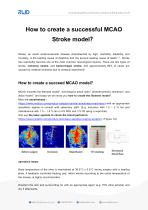 Website:
RWD Life Science
Website:
RWD Life Science
Catalog excerpts

How to create a successful MCAO Stroke model? Stroke, an acute cerebrovascular disease characterized by high, morbidity, disability, and mortality, is the leading cause of disability and the second leading cause of death 1, 5 . Stroke has reportedly become one of the most common neurological injuries. There are two types of stroke, ischemic stroke, and hemorrhagic stroke, and approximately 80% of cases are caused by cerebral ischemia due to cerebral embolisms 6 How to create a succeed MCAO model? MCAO includes the filament model 2 , homologous blood clots 3 , photothrombotic Ischemia 4, and distal model 7, and today we will show you how to create the filament model 2 . Mice are anesthetized : (https://www.rwdstco.com/product-category/animal-anesthesia-machines/) with an appropriate anesthetic regime in consult with veterinary staff. (E.g. induction with 1.5 – 2 % Iso and maintenance with 1.0 – 1.5 % Iso in 2/3 N2O and 1/3 O2 using a vaporizer). And use the laser speckle to check the blood perfusion: (https://www.rwdstco.com/product-item/laser-speckle-imaging-system/). (Figure 1A) operation steps: Body temperature of the mice is maintained at 36.5°C ± 0.5°C during surgery with a heating plate. A feedback controlled heating pad, which warms according to the rectal temperature of the mouse, is highly recommended. Disinfect the skin and surrounding fur with an appropriate agent (e.g. 70% ethyl alcohol) and dry it afterwar
Open the catalog to page 1
A midline neck incision is made and the soft tissues are pulled apart. The left common carotid artery (LCCA) is carefully dissected free from the surrounding nerves (without harming the vagal nerve) and a ligature is made using 6.0/7.0 string. 5.0 string can also be used. The left external carotid artery (LECA) is then separated and a second knot is made. Next, the left internal carotid artery (LICA) is isolated and a knot is prepared with a 6.0 filament. After obtaining good view of the left internal carotid artery (LICA) and the left pterygopalatine artery (LPA), both arteries are...
Open the catalog to page 2
Figure 2. Scheme of the vessel architecture supplying the brain (depicted in background) in the mouse. Different strains may show variations, for example the occipital artery sometimes leaves from the internal carotid artery. Reference: 1 Y. Dou, Z. Wang, and G. Chen, ‘The Role of Hydrogen Sulfide in Stroke’, Med Gas Res, 6 (2016), 79-84. 2 O. Engel, S. Kolodziej, U. Dirnagl, and V. Prinz, ‘Modeling Stroke in Mice – Middle Cerebral Artery Occlusion with the Filament Model’, J Vis Exp (2011). 3 R. Jin, X. Zhu, and G. Li, ‘Embolic Middle Cerebral Artery Occlusion (Mcao) for Ischemic Stroke...
Open the catalog to page 3All RWD Life Science catalogs and technical brochures
-
RWD Gradient Thermal Cycler
2 Pages
-
Rotary Microtomes S710
2 Pages
-
RWD Osmotic infusion Pump
2 Pages
-
RWD Syringe Pump R462
1 Pages
-
RWD Rotating impactor 68099Ⅱ
2 Pages
-
RWD Microcentrifuge M1324R
2 Pages
-
RWD Infusion imager RFLSI Ⅲ
2 Pages
-
RWD Surgical Instruments
18 Pages
-
RWD Veterinary medical equipment
32 Pages
-
RWD R415 Animal Ventilatorr
1 Pages
-
PRODUCT CATALOGUE 2017
51 Pages
-
2015 Product Catalogue
44 Pages
















































































